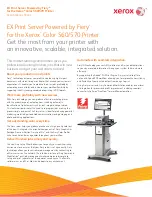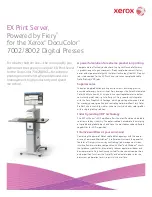
3
Download the required software
Digi provides several utilities that discover devices present on a network. You will need to download either the
Digi Discovery Utility
or
Digi Port Authority - Remote
.
1. Navigate to
www.digi.com/support/cpts8
.
2. Click the
Diagnostics, Utilities, and MIBs
link.
3. Select your operating system.
4. Download and run either the
Digi Discovery Utility
or
Digi Port Authority - Remote
.
If you want to manage your serial ports with Digi's RealPort software, download the RealPort software.
1. Navigate to
www.digi.com/support/cpts8
.
2. Click the
Drivers
link.
3. Select your operating system. A list of available downloads and release notes for your operating system appears.
4. Download the RealPort driver and the release notes.
Note
For Microsoft Windows operating systems, unzip the download package and run the executable file. For Linux or Unix operating systems, unload the release notes first
and follow the instructions in the release notes.
4
Configure the serial ports
Access the
Digi Connect Family User Guide
from the Documentation tab at
www.digi.com/support/cpts8
.
Use Digi Discovery Utility or Digi Port Authority—Remote to discover devices on your network and open the web interface.
1. In the list of discovered devices, select the ConnectPort TS 8/16 device.
2. If you are not using DHCP, configure the IP address.
3. Open the web interface. In the Digi Device Discovery Utility, click
Open web interface
. In Digi Port Authority-Remote, click
Device Configuration
.
4. A login prompt for the web interface appears. Enter the default username and password:
root
and
dbps
.
In the web interface, under
Configuration
, click
Serial Ports
.
Configure serial port settings using port profiles. Port profiles are a defined set of serial port parameters for a particular use. The web interface and User Guide contain
descriptions of the port profiles. For ConnectPort TS 8/16 products, Digi recommends the
RealPort
port profile. For help in configuring the device for use with other port
profiles, see the User Guide. To configure ports to use the RealPort port profile:
1. On the
Serial Port Configuration
page, click the port to be configured.
2. Click
Change Profile
.
3. In the list of profiles, select the
RealPort
port profile.
4. Click
Apply
.
For EIA-232 devices that will be connected using 8-wire cables, configure the
Altpin
setting. The default for this setting is off; it must be enabled as needed for each serial
port. For each applicable serial port:
1. Click
Advanced Serial Settings
.
2. Select the
Enable alternate pinout (altpin)
setting.
3. Click
Apply
.
The serial ports for ConnectPort TS 8/16 MEI products are set to EIA-232 by default. For serial ports that connect to EIA-422 or EIA-485 devices, configure the serial ports. For
each applicable serial port:
1. Click the serial port to select it.
2. On the
Serial Port Configuration
page, click the
Multiple Electrical Interface (MEI) Serial Settings
link.
3. Select
EIA-422/EIA-485
.
4. Select the number of differential wires the device uses for communication:
l
2 wires
: a half-duplex connection with shared transmit and receive wires.
l
4 wires
: a full-duplex connection with independent transmit and receive pairs. This is the default setting.
5. Select
Enable termination
if you require termination or use of biasing resistors across the lines. Enable this setting if the terminal server port is an endpoint
node of the EIA-422/485 network and you want termination or biasing. 2-wire mode uses termination or biasing at one of the end points; usually the Master
endpoint.
Note
The CTS and RTS controls signals are available as separate differential signals in the EIA-422/EIA-485 4-wire mode. Do not use these differential signals in 2-wire mode.
The CTS and RTS differential signals are
not
terminated or biased internally. If you require termination or biasing, it must be done externally.
Your ConnectPort TS device is now configured for basic serial port connectivity. For information on other configuration options and additional product information, see the
User Guide.
5
Locate the appropriate cable adapters for your product
The table below lists EIA-232 cable adapters that work with ConnectPort TS 8/16 products. For additional cabling information, go to
www.digi.com/support/cpts8
and click
the
Documentation
tab. To order cables, click
Cabling
.
Part number
Cable adapter
Application
76000697
Digi TS DB-9F Console Adapter (4-pk)
Bay Accelar, Nortel and other DB-9 DTE devices.
76000698
Digi TS DB-25M Console Adapter (4-pk)
Oracle Sparc, Oracle Ultra, terminal, printers and other DTE devices with DB-25 female ports.
76000699
Digi TS DB-25F Console Adapter (4-pk)
Cisco, IBM and other DTE devices with DB-25 male ports.
76000700
Digi TS DB-25M Modem Adapter (4-pk)
Modems and other DCE devices with DB-25 female ports.
76000701
Digi TS DB-9M Modem Adapter (4-pk)
Modems and other DCE devices with DB-9 female ports.
76000692
Digi TS DB-25M Printer Adapter (4-pk)
For use with printers. This adapter differs from a console adapter in that it uses the DTR signal
instead of RTS for hardware flow control.
76000631
Digi TS to Oracle Netra/Cisco Cable (single pk)
For use with Cisco and Oracle RJ-45 console ports. Also available in 8-pk and 16-pk quantities.
63000042-01
RJ-45 to RJ-45 Straight through Ethernet Cable
Can be used as a networking cable or combined with one of the adapters as a serial cable.
Note
Cable adapters are 8-wire. If you are using these cable adapters with modems, or other applications that require Data Carrier Detect (DC) control, you must enable the
alternate pinout setting, or ALTPIN, as shown in step 4.
6
Next steps
Digi Technical Support
: Digi offers multiple technical support plans and service packages to help our customers get the most out of their Digi product. For information on
Technical Support plans and pricing, contact us at 877.912.3444 or visit us at
www.digi.com/support
.



















